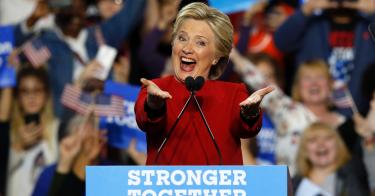Funny thing about smears made during a presidential campaign. The charges get banner headlines. The corrections? Not so much.
Consider the Clinton campaign’s charge in 2016 that a secret communications channel existed between Donald Trump and a Russian bank. That was big news five years ago.
There was just one hitch. According to an indictment recently handed down by a DC grand jury at Special Counsel John Durham’s behest, the “secret communications channel” theory just wasn’t true and had been identified as a “red herring” by those investigating it.
Still, Michael Sussmann, a DC lawyer working at the Perkins Coie law firm and a former political appointee in the Justice Department during the administration of President Bill Clinton, pushed it to the FBI anyway. More troublingly, as the indictment continues, “In assembling and conveying these allegations,” Sussmann “acted on behalf of specific clients,” including “the Hillary Clinton Presidential Campaign.”
>>> Election Panel’s Giving Twitter a Pass on Hunter Biden Laptop Cover-up Is a Travesty
Stop and think about it. If the charges in the indictment are true, someone working at the behest of Hillary Clinton’s presidential campaign pushed dubious, if not outright debunked, theories to the FBI in order to trigger a counter-intelligence and/or criminal investigation into their political rival, and then to leak the existence of that investigation to the press so that they would publish it.
According to information gleaned from the federal grand jury indictment, the plan allegedly played out in essentially five steps:
- First, the Clinton campaign used the left-leaning Perkins Coie law firm (listed in the indictment as “Law Firm-1”) which then engaged “opposition research” firm Fusion GPS (listed in the indictment as “U.S. Investigative Firm” and procurers of the infamous “Steele Dossier”) to spearhead the smear efforts under the cloak of attorney-client privilege.
- Second, Perkins Coie lawyers Marc Elias (listed in the indictment as Campaign Lawyer-1 and who also served as general counsel to the Clinton campaign) and Sussmann coordinated with an executive from a tech company to use his access to non-public internet server information in an effort to establish a connection—which turned out to be an entirely legal connection, mind you—between servers used by the Trump Organization and Alfa Bank
- Third, Sussmann—allegedly falsely posing as nothing more than a “concerned citizen”—approached his old buddy at the FBI (general counsel James Baker) and pitched the Trump Organization-Alfa Bank internet server activity as likely criminal behavior (while also allegedly lying that he was not acting on behalf of the Clinton campaign, which forms the basis for the criminal charge against him).
- Fourth, these same lawyers and opposition researchers disseminated this Trump-Alfa Bank smear to reporters who in turn dutifully published this baseless claim mere weeks before Election Day.
- Fifth, Clinton and her foreign policy campaign aide, Jake Sullivan—currently President Biden’s National Security Adviser—breathlessly promoted a Slate article on Clinton’s Twitter account and in a press release—pushing the Clinton Campaign’s own dubious opposition research.
To be sure, “opposition research” has been a part of political campaigns since the invention of political campaigns. But the Clinton camp went well beyond standard campaign operations in at least two major ways.
For one, opposition research is usually based on facts—a teenage DUI arrest, allegations of marital infidelity, etc. Second, campaign opposition researchers generally blast their “oppo” out to the media, but don’t enlist federal law enforcement to get involved. The Clinton campaign appears to have done both.
There were no illicit connections between the Trump Organization and Alfa Bank internet servers. The Sussmann indictment makes clear that the Clinton campaign knew that nothing in the internet traffic appeared nefarious. It was routine and easily explainable. Undaunted, Clinton’s team spoke of creating an “inference” so that the smear could be credibly pitched to the media, knowing that the average media security analyst would be unable to see through the false narrative.
More troublingly, and presumably to create a needed “news hook” to ensure that their media allies would publish the smear, they pushed the same claims to the FBI—albeit indirectly so that the FBI wouldn’t know it was coming from the campaign of Trump’s political rival.
>>> Hillary Clinton, the DNC and the Law
To its credit, the FBI swiftly concluded that the allegations were insufficient to establish a “secret communications channel” between Trump and Alfa Bank. But that wasn’t the point at all. The point was to create an “inference” of illicit communications so that the media would report that the FBI was investigating it. That was the “news hook” for the Clinton Campaign’s October surprise.
Durham’s indictment of Sussmann—who should of course be considered innocent until proven guilty—raises many, many more questions about other potential criminal actions. In fact, since the indictment came down, Durham has issued additional subpoenas to the Perkins Coie law firm and others.
To paraphrase a question that arose with another infamous dirty trickster: Who knew what when, and when did they know it? And more importantly, were any other laws allegedly broken?
This piece originally appeared in the the Daily Caller





